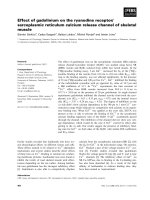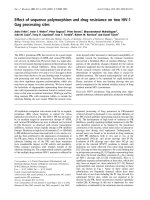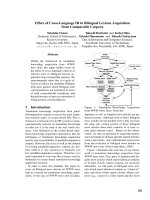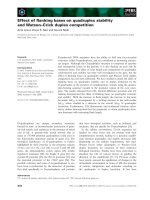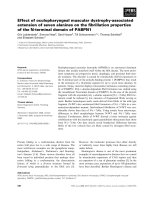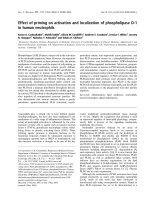Báo cáo khoa học: "Effect of article genotype and cutting type on the vegetative propagation of the pine hybrid (Pinus brutia (Ten) x Pinus halepensis (Mill)" pptx
Bạn đang xem bản rút gọn của tài liệu. Xem và tải ngay bản đầy đủ của tài liệu tại đây (921.42 KB, 8 trang )
Original
article
Effect of
genotype
and
cutting
type
on
the
vegetative
propagation
of
the
pine
hybrid
(Pinus
brutia
(Ten)
x
Pinus
halepensis
(Mill))*
K
Panetsos,
A
Scaltsoyiannes,
P
Alizoti
Laboratory
of
Forest
Genetics,
Department
of
Forestry
and
Natural
Environment,
Aristotelian
University
of
Thessaloniki,
54006
Thessaloniki,
Greece
(Received
16
February
1993;
accepted
12
April
1994)
Summary —
Improved
methods
to
propagate
vegetatively
selected
individuals
of
the
promising
arti-
ficial
pine
hybrid
Pinus
brutia
(Ten)
x
P
halepensis
(Mill)
are
required.
Repeated
spraying
with
200
mg·l
-1
BA
or
one
spraying
with
1
000
mg·l
-1
of
the
herbicide
Arsenal
on
the
stems
of
4-year-old
seedlings,
resulted
in
the
production
of
the
largest
possible
number
of
fascicle
shoots.
The
fascicle
shoots
produced
were
taken
as
cuttings
and
were
tested
for
rooting.
In
the
rooting
experiments
the
effect
of
genotype,
cutting
type,
cutting
size
and
auxin
treatment
were
investigated.
Genotype
and
cutting
type
proved
to
be
the
most
crucial
factors
for
rooting
and
clones
with
high
rootability.
Pinus
brutia
(Ten)
x
P
halepensis
(Mill)
I
induced
fascicle
shoot
/
genotype
effect
I
rooting
/
cutting
/
vegetative
propagation
Résumé—
L’effet
du
génotype
et
du
type
de
bouture
sur
la
multiplication
végétative
de
l’hybride
de
pin
(Pinus
brutia
(Ten)
x
Pinus
halepensis
(Mill)).
L’amélioration
des
méthodes
de
multiplica-
tion
végétative
des
individus
sélectionnés
de
l’hybride
artificiel
de
pin
Pinus
brutia
(Ten)
x Pinus
hale-
pensis
(Mill)
est
nécessaire.
Quatre
différents
régulateurs
de
croissance
(TIBA,
Alar,
GA
3,
BA)
ont
été
appliqués
avec
différentes
combinaisons
et
concentrations
sur
la
tige
de
plants
de
4
ans
de
cet
hybride
artificiel
afin
d’obtenir
l’induction
de
pousses
interfasciculaires
(tableau
I).
L’effet
du
meilleur
trai-
tement
(200
mg·l
-1
BA)
de
l’expérience
a
été
comparé
avec
celui
de
l’herbicide
Arsenal.
La
pulvérisation
répétée
de
200
mg·l
-1
BA
ou
une
pulvérisation
de
1000
mg·l
-1
d’Arsenal
sur
la
tige
de
plants
de
4
ans,
conduit
à
la
production
du
plus
grand
nombre
des
pousses
interfasciculaires
(tableau
II,
fig
1A).
Ces
pousses
ont
été
utilisées
comme
boutures
et
étudiées
pour
leur
enracinement.
Dans
cette
expérience
d’enracinement,
on
a
analysé
l’effet
du
génotype,
du
type
de
bouture,
de
la
taille
de
la
bouture
et
du
traitement
par
l’auxine.
Parmi
les
8
clones
testés,
on
a
observé
une
grande
variabilité
en
ce
qui
*
This
work
was
financially
supported
by
the
EEC
in
the
framework
of
the
Mediterranean
Integrated
Programmes
of
the
project
"Application
of
biotechnological
methods
for
the
mass
production
of
fast-
growing
Mediterranean
pines".
Abbreviations:
benzyladenine
(BA);
gibberelic
acid
(GA
3
);
triiodobenzoic
acid
(TIBA);
dimethylaminosuccinamide (Alar);
indole-3-butyric
acid,
potassium
salt
(K-IBA).
concerne
l’enracinement
(fig
2).
Les
boutures
interfasciculaires
se
sont
enracinées
plus
facilement
et
elles
ont
développé
un
meilleur
système
racinaire
que
celui
des
boutures
de
tige
(fig
1B,
1 C).
En
ce
qui
conceme
l’effet
du
génotype,
on
a
trouvé
que
quelques
clones
s’enracinent
facilement
ou
difficilement
indépendamment de
leur hauteur ou
du
traitement
par l’auxine
(tableau
III).
Les
concentrations
variées
d’auxine
(0,
4000,
8000
ppm
K-IBA)
influent
différemment
sur
les
2
types
de
bouture
(fig
3).
Les
plan-
tules
provenant
des
pousses
interfasciculaires
se
caractérisent
par
leur
vigueur
et
leur
orthotropie
(fig
1D).
P
brutia
(Ten)
x
P
halepensis
(Mill)
/
pousse
interfasciculaire
/
effet
du
génotype
/
enracine-
ment /
bouture
/
multiplication
végétative
INTRODUCTION
The
artificial
pine
hybrid,
Pinus
brutia
(Ten)
x
P
halepensis
(Mill)
F1,
is
promising
for
afforestation
in
Greece
because
of
its
suc-
cessful
adaptation
in
various
environments
and
growth
vigour
in
comparison
to
its
par-
ents
(Panetsos
et al,
1983;
Panetsos,
1986b).
However,
the
difficulty
in
obtaining
a
large
quantity
of
hybrid
seed,
especially
from
parents
with
high
specific
combining
ability,
limits
its
potential
for
large-scale
planting.
Thus,
reliable
methods
for
mass
vegetative
propagation
of
superior
hybrid
trees
are
urgently
needed.
Until
some
years
ago,
among
the
vege-
tative
propagation
methods
(traditional
and
in
vitro)
only
grafting
was
applied
with
great
success
to
the
above
hybrid
and
its
parents
(Panetsos,
1986a).
Rooting
of
conifers
(especially
of
mature
trees)
is
generally
con-
sidered
very
difficult
and
success
is
still
too
low
to
allow
operational
use,
except
in
some
cases
where
young
seedlings
or
juvenile
stock
plants
were
used.
According
to
Foster
(1990),
systems
for
the
large-scale
produc-
tion
of
rooted
cuttings
have
been
developed
for
many
conifer
species.
Traditionally,
environmental
factors
affect-
ing
rootability
of
conifer
cuttings
have
received
the
most
attention
when
develop-
ing
production
systems,
but,
as
Foster
(1990)
states,
genetic
differences
in
root-
ing
ability
among
clones
seem
to
be
an
almost
universal
phenomenon
for
forest
tree
species.
One
of
the
most
important
physio-
logical
factors
affecting
rootability
of
conifer
cuttings
is
considered
to
be
juvenility,
asso-
ciated
with
the
age
of
the
ortet.
On
the
other
hand,
one
major
aim
of
vegetative
propa-
gation
is
to
multiply
trees
old
enough
to
have
demonstrated
their
superior
characteristics
(Girouard,
1974).
In
the
last
few
decades,
multiplication
of
conifers
through
micro-
propagation
techniques
has
been
an
attrac-
tive
possibility.
However,
most
conifers
have
been
so
difficult
to
propagate
in
vitro,
espe-
cially
from
mature
tissues
(except
for
a
few
cases
(eg,
Horgan
and
Holland,
1989;
Scalt-
soyiannes
et al,
1994))
that
it
does
not
per-
mit
the
commercial
application
of
this
pro-
cess.
According
to
Mergen
and
Simpson
(1964),
pine
fascicle
shoots
could
provide
a
large
number
of
propagules.
The
fact
that
this
material
rooted
more
readily
than
stem
cuttings
from
long
shoots
(Libby
et al,
1972;
Whitehill
and
Schwabe,
1975;
Inglis,
1984)
is
probably
due
to
its
juvenile
state
(Sacher,
1954;
Abo
El-Nil,
1982)
and
the
higher
level
of
endogenous
root
promoters
(Hong,
1969).
In
1959,
Reines
and
MacAlpine
demon-
strated
stimulation
of
fascicle
buds
of
P
eliot-
tii
by
the
removal
of
terminal
buds.
Kum-
merow and
Hoffmann
in
1963,
reported
that
kinetin
could
stimulate
the
growth
of
fascicle
buds.
Other
workers
later
reported
that
removal
of
terminal
buds
combined
with
treatment
of
plants
with
cytokinin-like
sub-
stances
could
stimulate
fascicle
bud
devel-
opment
and
also
that
this
type
of
material
could
root
more
readily
than
stem
cuttings
(Hong,
1969;
Kiang
et al,
1974;
Whitehill
and
Schwabe,
1975;
Inglis,
1984;
Scalt-
soyiannes,
1988).
The
objective
of
the
present
study
is
the
investigation
of:
a)
the
stimulation
and
devel-
opment
of
fascicle
shoots
of
the
pine
hybrid
P
brutia
(Ten)
x
P
halepensis
(Mill);
and
b)
the
vegetative
propagation
of
selected
indi-
viduals
of
the
hybrid
by
using
fascicle
shoots
as
cuttings.
MATERIALS
AND
METHODS
Induction
and
development
of
fascicle
shoots
Experiment
1.
Effect
of
growth
regulators
Four-year-old
seedlings
of
P
brutia
(Ten)
x
P
halepensis
(Mill)
<
1.2
m
in
height,
were
selected
in
January,
for
their
uniform
growth
and
were
placed
in
a
greenhouse
(14-29°C)
to
stimulate
fascicle
shoot
development
with
growth
regula-
tors
after
excision
of
terminal
and
lateral
buds.
Daylength
was
maintained
at
18
h
by
supple-
mentary
lighting,
provided
by
high
pressure
lamps
(HPI/T,
SON/T,
400
W).
The
seedlings
were
fer-
tilised
at
3-month
intervals
by
applying
Compresal
Supra
(12 N + 12 P + 17 K + 2 Mg
+ micronutri-
ents).
Chemical
treatments
and
their
concentra-
tions
are
shown
in
table
I.
Twelve
seedlings
per
treatment
were
used.
The
above
treatments
were
applied
5
times,
every
7
d,
on
the
whole
foliage
of
the
seedlings
with
a
compressed
air
sprayer
and
80
ml
solution
was
enough
to
run-off
the
entire
plant.
The
solutions
were
prepared
from
stock
solutions
stored
at
5°C.
A
mixture
of
Triton
100
and
Triton
20
at
0.01
%
and
0.005%
(V/V),
respec-
tively,
was
used
as
surfactant.
To
provide
unifor-
mity
in
our
measurements,
the
assessment
of
fascicle
shoot
number
referred
to
a
length
of
20
cm
on
the
main
stem
and
were
recorded
8
weeks
after
the
first application
of
the
chemical.
Fascicle
shoots
greater
than
10
mm
were
considered
as
induced
shoots.
Experiment
2.
Effect
of
the
herbicide
imazapyr
(Arsenal,
CYANAMID)
The
following
spring,
selected
plant
material
of
the
same
origin
and
of
about
the
same
age
and
height
as
in
Experiment
1 was
sprayed
(table
II)
with:
a)
1
000
mg·l
-1
herbicide
imazapyr
(Arsenal)
(ai
250
g·l
-1
)
once
for
induction
and
develop-
ment
of
fascicle
shoots;
and
b)
200
mg·l
-1
BA,
which
proved
to
be
one
of
the
best
treatments
from
Experiment
1.
It
is
noteworthy
that
in
the
Arsenal
treatment
no
bud
excision
occurred,
in
contrast
to
BA
treat-
ment
which
was
applied
as
in
Experiment
1.
Growth
conditions
(environment,
nutrition,
etc)
of
the
present
experiment
were
as
similar
to
those
in
Experiment
1
as
possible.
Rooting
Experiment
3
In
order
to
test
clonal
and
cutting
type
effects
on
rooting
ability
of
the
pine
hybrid
P
brutia
(ten)
x
P
halepensis
(Mill),
the
following
experiment
was
carried
out.
Two
types
of
cutting,
12-15
cm
long,
were
tested
for
rooting:
a)
induced
fascicle
shoots,
derived
from
the
application
(in
January)
with
Arsenal
(1
000
mg·l
-1
)
on
8
clones
4-5
years
old
(height >
1.5
m)
growing
in
the
field;
and
b)
stem
cuttings
(normal)
from
the
same
clones.
The
induced
fascicle
cuttings
were
collected
at
the
end
of
May
and
were
semi-lignified
to
suc-
culent
with
both
juvenile
leaves
and
needle
fas-
cicles.
On
the
same
ortet
we
could
find
simul-
taneously
induced
fascicle
shoots
and
non-induced
shoots
(normal)
after
the
Arsenal
application.
The
following
treatments
were
applied
to
each
type
of
cutting
and
each
of
the
8
clones:
a)
con-
trol
(no
treatment);
b)
K-IBA
4
000
mg·l
-1
(potas-
sium
salt);
and
c)
K-IBA
8
000
mg·l
-1
(potassium
salt).
The
cutting
base
was
quick-dipped
in
auxin
solution
for
5
s,
and
allowed
to
dry
before
inser-
tion into
the
heated
rooting
bench
(temperature
adjusted
to
24°C)
equipped
with
a
special
inter-
mittent
mist
system
(3
s/15
min)
for
12
h
per
day.
Rooting
medium
consisted
of
perlite
and
peat
1:1
v/v,
in
a
mixture.
Photoperiod,
light
quality
and
ambient
temperature
remained
the
same
as
in
Experiment
1.
Cuttings
were
watered
with
a
solu-
tion
of
fungicide
Captan
at
2-week
intervals.
The
experimental
design
was
a
randomised
complete
block
design
(treatment
x
cutting
type
x
clone
x
replication)
with
4
replications
and
5
cuttings
per
plot
(ie
a
total
number
of
120
cuttings/clone).
Rooting
was
recorded
4
months
after
insertion
of
the
cuttings.
Experiment
4
Because
the
induced
fascicle
cuttings
of
the
pre-
vious
experiment
reached
the
length
of
12-15
cm
the
second
year
after
Arsenal
treatment,
the
fol-
lowing
year
we
tested
shorter
cuttings
4-5
cm
long
which
were
collected
2-3 months
after
the
application
with
Arsenal.
Induced
fascicle
cuttings
derived
from
the
best
and
the
worst
clone
(3
and
1,
respectively)
of
the
previous
experiment
were
treated
with
2
000
mg·l
-1
K-IBA
(potassium
salt).
The
experimental
design
and
all
other
conditions
were
the
same
as
in
Experiment 3.
RESULTS
Induction
and
development
of
fascicle
shoots
As
shown
in
table
I,
there
were
significant
differences
in
the
number
of
fascicle
shoots
induced
after
application
of
the
various
growth
regulators.
The
untreated
plants
pro-
duced
fewer
shoots
which
are
longer
close
the
bud
excision
site,
compared
with
the
treated
ones.
Cytokinin-treated
plants
(100-400
mg·l
-1
BA)
produced
the
largest
number
of
fascicle
shoots
which
appeared
earlier
(3rd
week
after
bud
excision)
than
those
of
the
other
treatments.
TIBA
and
Alar
applications
were
found
to
be
ineffective
when
applied
alone
as
well
as
in
combination
with
BA.
The
appli-
cation
of
GA
3
alone
or
in
combination
with
BA
appeared
to
depress
bud
induction.
The
herbicide
(Arsenal)
effect
on
shoot
induction
and
their
outgrowth
(table
II,
fig
1 A),
appeared
to
be
similar
to
that
caused
by
the
BA
treatment,
which
proved
to
be
the
most
promising
treatment
in
Experi-
ment
1.
In
all
the
above
cases
the
induced
fas-
cicle
shoots
were
characterized
by
vigor-
ous
growth
and
open
apical
buds.
Rooting
experiments
Clones
exhibited
great
variation
in
their
root-
ing
percentages,
regardless
of
cutting
type
(stimulated
or
normal)
(fig
2),
which
ranged
from
82%
to
3%.
Figures
1B and
1C
also
indicate
that
cutting
type
is
another
impor-
tant
factor
affecting
rootability
regardless
of
clone.
Moreover,
it
should
be
pointed
out
that
plantlets
derived
from
fascicle
shoots
were
orthotropic,
fast
growing,
and
exhib-
ited
good
acclimatization
in
contrast
to
those
originating
from
normal
cuttings
(fig
1
D).
The
three
levels
of
K-IBA
(fig
3)
affected
the
2
cutting
types
differently.
Normal
cut-
tings
responded
positively
to
the
increase
of
the
auxin
level,
while stimulated
ones
responded
negatively.
The
results
in
table
III
can
be
compared
with
the
performances
of
clones
1
and
3
in
figure
2,
which
shows
that
cutting
length
had
no
effect
on
rooting
and
also
that
geno-
type
remains
the
most
important
factor.
DISCUSSION
The
most
successful
treatments
for
the
induction
and
development
of
fascicle
shoots
on
P
brutia
(Ten)
x
P
halepensis
(Mill)
seedlings
were:
a)
the
application
of
BA
(100-400
mg·l
-1
)
in
conjunction
with
the
removal
of
buds;
and
b)
spraying
with
the
herbicide
imazapyr
(1
000
mg·l
-1
Arsenal)
without
bud
removal.
The
cytokinin
effect
is
an
agreement
with
results
obtained
from
similar
work
on
3-year-old
P
caribaea
(Inglis,
1984)
and
P
sylvestris
(Whitehill
and
Schwabe,
1975;
Phillion
et al,
1983).
The
herbicide
(Arsenal)
effect
on
induction
of
fascicle
shoots
was
first
demonstrated
by
Christensen
(1988).
Although
the
herbicide
interference
in
the
plant regulation
balance
is
unknown,
it
was
observed
that
its
appli-
cation
caused
terminal
bud
decaying
and
fascicle
shoot
induction.
According
to
our
results
and
those
men-
tioned
by
Wickson
and
Thimann
(1958)
it
is
assumed
that
an
antagonism
exists
within
buds
between
uxin
and
endogenous
cytokinin,
which
on
several
occasions
results
in
the
dominance
of
the
apical
bud
(higher
auxin
level).
Growth
of
the
inhibited
fascicle
shoots
seems
to
be
accomplished
when
endogenous
cytokinin
levels
are
increased,
either
by
lateral
and
terminal
bud
excision
or
cytokinin
treatment.
TIBA,
Alar
and
GA
3
treatments
reduced
significantly
the
number
of
fascicle
shoots
induced,
which
is
consistent
with
the
find-
ings
of
Inglis
(1984).
According
to
Libby
et al (1972),
2 require-
ments
must
be
met
for
large-scale
propa-
gation:
a)
production
of
a
large
number
of
propagules;
and
b)
development
of
condi-
tions
for their
successful
rooting
and
estab-
lishment.
In
our
case,
fascicle
shoots
seem
to
satisfy
the
above-mentioned
prerequi-
sites,
since
they
can
provide
almost
as
many
propagules
as
the
number
of
brachyblasts,
and
also
root
more
readily
than
cuttings
orig-
inating
from
stem
shoots.
From
our
results
it
is
proved
that
the
more
critical
factors
affecting
rooting
of
fascicle
shoots
are
the
genotype
and
the
type
of
cut-
tings.
As
regards
genotype,
some
clones
root
readily
and
others
poorly,
regardless
of
the
cutting
type
and
hormone
level.
Several
other
workers
have
also
noticed
the
effect
of
genotype
on
rooting
of
conifer
cuttings
(Thulin
and
Faulds,
1968;
Kleinschmit
and
Schmidt,
1977;
Donald,
1987;
Foster,
1990).
The
higher
rootability
of
fascicle
shoot
cuttings
compared
with
that
of
normal
ones
was
also
demonstrated
by
many
other
work-
ers
(Inglis,
1984;
Donald,
1987),
a
fact
that
could
be
attributed
to
their
possible
juvenile
state
(Sacher,
1954;
Libby
et al,
1972;
Abo
El-Nil,
1982)
and
the
higher
level
of
endoge-
nous
root
promoters
of
these
shoots
(Hong,
1969).
Plants
derived
from
rooted
fascicle
shoot
cuttings,
one
year
after
transplanting,
remained
orthotropic
and
exhibited
growth
vigour
and
good
acclimatization.
Orthotropic
behaviour
exhibited
in
plantlets
derived
from
fascicle
cuttings
was
also
noticed
by
Alazard
and
Kadio
(1983)
and
Scaltsoyiannes
et al
(1992).
Fascicle
shoots
that
are
4-5
cm
long
can
be
used
for
the
full
exploitation
of
plant
propagules
and
time
could
be
saved
as
they
reach
that
size
in
only
2
months
from
shoot
induction.
This
makes
this
technique
pro-
ductive
and
economically
successful.
Finally,
preliminary
experiments
con-
ducted
with
mature
tissues
(scions)
of
a
pine
hybrid
P
brutia
(Ten)
x
P
halepensis
(Mill)
that
is
23
years
old,
gave
us
encouraging
results
on
induction
and
rooting
of
fascicle
shoots.
ACKNOWLEDGMENTS
Special
thanks
are
due
to
P
Tsoulpha
and
C
Papadouli
for
their
excellent
assistance
with
lab-
oratory
and
greenhouse
work.
REFERENCES
Abo
El-Nil
MM
(1982)
Micropropagation
of
Pinus radiata.
Ind Ind
Biotech
6,
148-149
Alazard
P,
Kadio
A
(1983)
Croissance
juvenile
des
bou-
tures
de
pin
maritime.
Ann
Rech
Sylvicol 119-155
Christensen
P
(1988)
Danish
results
with
a
new
herbi-
cide,
imazapyr,
in
forestry.
Asp
Appl
Biol 16,
105-
112
Donald
DGM
(1987)
Vegetative
propagation
of
pines,
using
cuttings.
S
Afr
For
J 140,
16-23
Foster
GS
(1990)
Genetic
control
of
rooting
ability
of
stem
cuttings
from
loblolly
pine.
Can
J
For
Res
20, 1361-1367
Girouard
RM
(1974)
Propagation
of
spruce
by
stem
cut-
tings.
N Z J For Sci 4,
140-149
Hong
SO
(1969)
Endogenous
growth
substances
affect-
ing
cuttings
of
pine.
Res
Rep
Inst
For
Gen
7,
1-33
Horgan
K,
Holland
L
(1989)
Rooting
micropropagated
shoots
from
mature
radiata
pine.
Can
J
For
Res
19,
1309-1315
Inglis
J
(1984)
The
effects
of
some
growth
substances
on
the
promotion
and
rooting
of
interfascicular
shoots
in
Pinus
caribaea.
Commonw
For
Rev
63,
115-120
Kiang YT,
Rogers
OM,
Pike RB
(1974)
Vegetative
prop-
agation
of
eastern
white
pine
by
cuttings.
N Z
J For
Sci 4, 153-161
Kleinschmit
J,
Schmidt
J
(1977)
Experiences
with
Picea
abies
cuttings
propagation
in
Germany
and
prob-
lems connected
with
large-scale
application.
Silv
Gen
26, 197-203
Kummerow
J,
Hoffmann
DE
CA
(1963)
Der
einfluss
von
kinetin
aut
die
rubeperiode
der
Kurztriebe
von
Pinus
radiata.
Ber
Dtsch
Bot
Ges
76,
189-196
Libby
WJ,
Brown
AG,
Fielding
JM
(1972)
Effects
of
hedg-
ing
Radiata
pine
on
production,
rooting
and
early
growth
of
cuttings.
N Z J For Sci 2,
263-283
Mergen
F,
Simpson
B
(1964)
Asexual
propagation
of
pines
by
rooting
needle
fascicles.
Silv
Gen
13, 133-1
Panetsos
KP,
Scaltsoyiannes
A,
Mitsopoulos
D
(1983)
Artificial
hybrids
between
Pinus
brutia
(Ten)
x
P
halepensis (Mill)
in
Greece.
Growth-Adaptation.
Publ
Lab
For
Gen
Plant
Breed,
Thessaloniki,
Greece
Panetsos
KP
(1986a)
Forest
Tree
Breeding.
Giapoulis-
Giahoudis,
Thessaloniki,
Greece
(in
Greek)
Panetsos
KP
(1986b)
Genetics
and
Breeding
in
the
group
halepensis.
For Mediterr,
vol
VIII,
5-12
Philion
BJ,
Whittaker
J,
Bunting
WR
(1983)
Promotion
of
fascicular
bud
development
in
young
Pinus
sylvestris
(L)
seedlings
selected
for
cloning.
Plant
Propagator
29, 4-5
Reines
M,
McAlpine
RG
(1959)
The
morphology
of
nor-
mal
callused
and
rooted
dwarf
shoots
of
slash
pine.
Bot Gaz 121, 118-124
Sacher
JA
(1954)
Structure
and
seasonal
activity
of
the
shoot
apices
of
Pinus
lambertiana
and
Pinus
pon-
derosa.
A
J
Bot
41,
749-759
Scaltsoyiannes
A
(1988)
Micropropagation
of
Pinus
bru-
tia
(Ten)
x
P
halepensis
(Mill)
and
its
role
in
conifer
breeding
programmes.
Doctorate
Thesis.
Aristotelian
University
of
Thessaloniki,
Greece
(in
Greek)
Scaltsoyiannes
A,
Panetsos
KP,
Alizoti
P
(1992)
Inter-
fascicular
shoot
induction -
a
basic
pretreatment
for
the
vegetative
propagation
of
the
pine
hybrid
Pinus
brutia
(Ten)
x
P
halepensis
(Mill).
Proc
4th
Ann
Conf
Genetics
and
Breeding
of
Plants
after
2000,
Greek
Scientific
Society
of
Genetics
and
Breeding
of
Plants
(in
press)
Scaltsoyiannes
A,
Panetsos
KP,
Economou
A,
Tsoul-
pha
P
(1994)
Micropropagation
of
the
pine
hybrid
Pinus
brutia
(Ten)
x
P
halepensis
(Mill)
by
culturing
fascicle
shoots.
Ann Sci For 51,
175-182
Thulin
IJ,
Faulds
T
(1968)
The
use
of
cuttings
in
breed-
ing
and
afforestation
of
Pinus
radiata.
N Z
J For Sci
13, 66-77
Whitehill
SJ,
Schwabe
NW
(1975)
Vegetative
propaga-
tion
of
Pinus
sylvestris.
Phys
Plant 35, 66-71
Wickson
ME,
Thimann
KW
(1958)
The
antagonism
of
auxin
and
kinetin
in
apical
dominance.
Phys
Plant
11, 62-74



